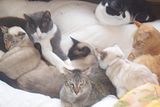This is the first article: (I will explain more about why I'm writing and asking for help here from you guys)
The Daily Collegian (it's a student paper that's written by the students of PSU)
Feral cats threaten university and students
A small population of feral cats has been spotted on Penn State's campus -- and they're more dangerous than most people might think, university officials said Wednesday.
The pack of cats, which has been seen near the Penn Stater Conference Center Hotel, descended from domestic cats released into the wild generations ago, university spokeswoman Lisa Powers said.
"Feral cats have been born in the wild, live in the wild and have never been domesticated," Powers said. "They can be aggressive, adverse to human contact and are much more likely to scratch and bite than domesticated cats."
Feral cats are easily confused with house cats but can be antagonistic when approached, potentially spreading diseases.
"They are a cause for concern for the health and safety of employees, visitors and the children at the daycare center in that area," Powers said.
Risks include the spread of Cat Scratch Disease (CSD), a bacterial infection. Most people with CSD were recently scratched or bitten by a cat and develop a mild infection at the point of injury, according to the Centers for Disease Control and Prevention.
But encounters can be more dangerous. Those who are bitten or scratched by the feral cats may be at risk for tetanus and rabies, and the feces of feral cats may carry parasites, including roundworms, hookworms and ringworm.
After receiving word of the cats, the university's Office of Environmental Health and Safety and members of an Animal Response Team worked to solve the problem. They plan to relocate the pack with the help of the local Humane Society, dispatching a pest company to snare the feral felines.
The university is also removing food sources that may be attracting the cats.
"We discovered that some individuals may have been feeding these feral cats," Powers said. "We have now asked them to stop feeding them for the safety of our campus community."
Powers said those in State College should refrain from releasing pets into the wild because of the threat these animals may cause to the community in the future.
"Cats are able to breed when they are six months old, and a pair of breeding cats, which can have two or more litters per year, can exponentially produce 420,000 offspring over a seven-year period," Powers said. "People who have pets are not doing them any favors by 'freeing' them."
Here is the second article:
Feral cat advocates call for safe removal
Penn State officials say a pack of feral cats roaming the area poses a risk because they can be "aggressive and adverse to humans."
But State College resident Shirley Fonda said she disagrees -- for her, the administration's decision to oversee the relocation of the cats is "ridiculous."
In fact, she said wild cats are often afraid of humans, and she believes she can turn any feral feline into "a loving pet that can find a home."
Over the past 11 years, the 73-year-old State College resident said she has taken in 970 abandoned cats. She spent the 25 years before that as a wildlife rehabilitator for the Pennsylvania Game Commission, giving her a solid judgment of what threat, if any, is posed by the colony of cats near Penn State, she said.
Both Fonda and university personnel agree that feral cats are not a new problem at Penn State, but the sides differ on how to best control the animals.
University spokeswoman Jill Shockey said the university has been responding to periodic reports of feral cat sightings, most recently in July. The university discourages people from feeding the cats in hopes that they return to nearby woods.
If a sighting is reported, the university enlists the assistance of a pest control service to locate and transport the cats to a local humane society, Shockey said.
Once the cats are transferred to an outside organization, the fate of the animals is out of Penn State's control. The names of specific companies used were not available, Shockey said.
Penn State is by no means in the process of "rounding up the cats" at this time, she said. But Fonda and others who oppose this method of action worry the felines will be euthanized at the shelters.
They're advocating for "Trap, Neuter, Return," a method they say would be less harmful to the animals.
Donna Herrmann of the Hundred Cat Foundation Inc., a local service specializing in this procedure, said it safely addresses many issues surrounding feral cats -- spaying and neutering them, vaccinating against rabies and tagging their ears to identify those who have been treated before they are returned to the wild.
"When you have a college community, you have stray cats and you have feral cats, so it's simply a humane way to deal with the problem," Herrmann said.
She offered to provide this service to Penn State free of charge several years ago, she said, but was declined.
According to the Web site for Alley Cat Allies -- a national group that calls itself "the cat's leading advocate" and has taken interest in the situation at Penn State -- Trap, Neuter, Return programs have been successfully implemented at other colleges with feral cats, including Stanford University, Auburn University and North Carolina State University.
And Herrman still hopes Penn State will reconsider its position on the issue.
"We stand ready to help," she said. "We have since the beginning."







 Reply With Quote
Reply With Quote And because there are so amny many feral Cats a lot of government agencies are washing their hands and declaring them to be wild life.
And because there are so amny many feral Cats a lot of government agencies are washing their hands and declaring them to be wild life.










Bookmarks